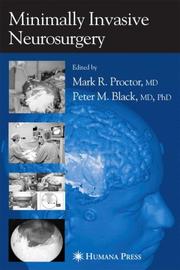| Listing 1 - 10 of 35 | << page >> |
Sort by
|

ISBN: 9781588290427 1588290425 9781592598434 1617373206 9786610359691 1280359692 1592598439 Year: 2005 Publisher: Totowa, N.J. : Humana Press,
Abstract | Keywords | Export | Availability | Bookmark
 Loading...
Loading...Choose an application
- Reference Manager
- EndNote
- RefWorks (Direct export to RefWorks)
In recent years, elucidation of many exciting details of the complex cellular and molecular processes involved in the initiation, progression, and clinical and biological behavior of brain tumors has greatly deepened our understanding of these cancers, and is now leading to new paradigms in their diagnosis and treatment. In Brain Tumors, Francis Ali-Osman, DSc, has assembled a panel of leading experts to summarize and illuminate the full range of recent research advances in their rapidly evolving field, with particular emphasis on those that are providing novel insights into the disease. The chapters critically assess current knowledge and the challenges of the future in relevant areas of brain research, including basic mechanisms of neuro-oncogenesis, molecular neurobiology, genetics, epidemiology, pathology, immunology, and therapy. New knowledge is critically presented on molecular profiling, molecular pathology and classification, in vitro and in vivo brain tumor models, brain metastasis, and progenitor cell biology. They also discuss in depth the cellular and genetic pathways involved in brain oncogenesis, malignant progression, and therapeutic response, highlighting oncogenes and tumor suppressor genes, DNA damage and repair, invasion and migration, cell cycle, growth factors, signaling, apoptosis, and developmental biology. The discussion of brain tumor therapy focuses on advances in pharmacological thinking, therapeutic modalities, novel therapeutic targets, rational drug design, gene and viral therapies, drug delivery and the blood-brain barrier, immunotherapy, and brain imaging. Authoritative and comprehensive, Brain Tumors provides an essential state-of-the-art guide to productive work across the entire range of basic and clinical research in neuro-oncology today. For the both active researcher and the trainee, the book will provide an appreciation of new neuro-oncology concepts and facilitate incorporating them into their own ongoing research.
Brain Neoplasms. --- Brain --- Cerveau --- Tumors. --- Tumeurs --- Brain -- Tumors. --- Brain Diseases --- Central Nervous System Neoplasms --- Nervous System Neoplasms --- Central Nervous System Diseases --- Nervous System Diseases --- Neoplasms by Site --- Diseases --- Neoplasms --- Brain Neoplasms --- Medicine --- Health & Biological Sciences --- Oncology --- Tumors --- Medicine. --- Cancer research. --- Biomedicine. --- Cancer Research. --- Oncology. --- Cancer research
Book
ISBN: 9783642042034 9783642042027 Year: 2011 Publisher: Berlin, Heidelberg Springer Berlin Heidelberg
Abstract | Keywords | Export | Availability | Bookmark
 Loading...
Loading...Choose an application
- Reference Manager
- EndNote
- RefWorks (Direct export to RefWorks)
The brainstem includes numerous pathways connecting different brain areas and the spinal cord, neural networks with coordinating tasks, and brainstem nuclei. Consequently its topography is complex, and even experienced neurologists find it challenging to localize brainstem lesions and diagnose brainstem disorders. This richly illustrated book provides a comprehensive review of brainstem disorders and presents the relevant clinical knowledge necessary for diagnosis. The opening sections document the brainstem neuroanatomy and discuss current diagnostic methods. The entire spectrum of clinical findings in brainstem disorders is then described, and topodiagnostic aspects of the neurological findings are explained in detail. The descriptions of brain stem disorders are consistently structured and are supported by many MR images and short case reports. In addition to primary brainstem lesions, such as vascular brainstem syndromes, other disorders are considered that do not exclusively show brainstem symptoms or signs, e.g., multiple sclerosis. This book will serve as an invaluable reference work for neurologists in clinical practice or further education.
Neuropathology --- neurologie --- Surgery --- neurochirurgie --- Human medicine --- Radiotherapy. Isotope therapy --- radiologie --- geneeskunde --- hersenen --- Brain Stem --- Brain Diseases --- Brain stem --- Tronc cérébral --- physiopathology. --- diagnosis. --- Diseases --- Diagnosis --- Maladies --- Dépistage --- EPUB-LIV-FT LIVMEDEC SPRINGER-B
Book
ISBN: 9781848820708 9781848820777 9781848820692 Year: 2010 Publisher: London Springer London
Abstract | Keywords | Export | Availability | Bookmark
 Loading...
Loading...Choose an application
- Reference Manager
- EndNote
- RefWorks (Direct export to RefWorks)
Neurocritical Care: A Guide to Practical Management provides clear and concise guidelines for the clinician, on the management of adult brain injured patients. It steers the clinician through the complicated decisions that are demanded in these cases, involving initial assessment, interpretation of radiological investigations, referral to a Regional Neurosurgical Center, prevention of secondary brain injury and the management of complex clinical scenarios such as Status epilepticus. This book will prove an indispensible aid for making these critical decisions. Including tried and tested proformas for swift and accurate communication of information to Regional Neurosurgical Centers, this book equips the clinician to get the most out of these specialist services. This book also addresses the difficult area of defining futility and withdrawal of care, ranging from the role of neuro-radiological imaging in aiding these decisions to a discussion of the complex ethical dilemmas that the clinician is inevitably faced with. A comprehensive easy-reference, Neurocritical Care is essential reading for those working within the primary referring centre in Emergency Medicine, Anesthesia, Intensive Care and Surgery. John P. Adams, MB ChB MRCP FRCA ATLS PGD - MedSch (Anesthesia) is Consultant Anesthetist with an interest in Neuroanesthesia and Anesthesia for Endocrine Surgery at Leeds Teaching Hospitals NHS Trust, UK. Dominic Bell, FFA.RCS MB ChB MPhil is Consultant in Intensive Care and Anesthesia at Leeds Teaching Hospitals NHS Trust, UK. Justin McKinlay, MA (Oxon) BM Bch FRCA is Consultant Anesthetist and Honorary Senior Lecturer at Leeds Teaching Hospitals NHS Trust, UK.
Anesthesiology --- Radiotherapy. Isotope therapy --- Neuropathology --- Surgery --- neurologie --- hersenen --- anesthesie --- neurochirurgie --- radiologie --- Brain Injuries --- Critical Care --- Neurological intensive care --- Brain --- Soins intensifs en neurologie --- Cerveau --- therapy. --- methods. --- Wounds and injuries. --- Lésions et blessures --- EPUB-LIV-FT LIVMEDEC SPRINGER-B
Book
ISBN: 9783211094693 3211094687 9783211094686 9786612019623 1282019627 3211094695 Year: 2008 Publisher: Vienna : Springer,
Abstract | Keywords | Export | Availability | Bookmark
 Loading...
Loading...Choose an application
- Reference Manager
- EndNote
- RefWorks (Direct export to RefWorks)
Cerebral hemorrhage is a common and often fatal subtype of stroke. while in the past it has received relatively little attention compared to ischemic stroke, there have been major advances in our understanding of this devastating form of stroke. The papers by world experts cover the field from molecular biology to clinical trials.
Medicine & Public Health. --- Neurosurgery. --- Neurology. --- Medicine. --- Médecine --- Neurologie --- Brain. --- Brain --- Intracranial Hemorrhages --- Cerebrovascular Disorders --- Hemorrhage --- Pathologic Processes --- Vascular Diseases --- Brain Diseases --- Pathological Conditions, Signs and Symptoms --- Cardiovascular Diseases --- Central Nervous System Diseases --- Nervous System Diseases --- Diseases --- Cerebral Hemorrhage --- Medicine --- Surgery & Anesthesiology --- Health & Biological Sciences --- Surgery - General and By Type --- Neurology --- Hemorrhage. --- Cerebral hemorrhage --- Nervous system --- Neuropsychiatry --- Cerebrovascular disease --- Nerves --- Neurosurgery --- Surgery --- Neurology . --- Surgery.

ISBN: 9781588293558 1588293556 9781592599455 1617375160 9786610358908 1280358904 1592599451 Year: 2005 Publisher: Totowa, N.J. : Humana Press,
Abstract | Keywords | Export | Availability | Bookmark
 Loading...
Loading...Choose an application
- Reference Manager
- EndNote
- RefWorks (Direct export to RefWorks)
The recent explosive growth in the study of status epilepticus (SE), an epileptic seizure that threatens to produce new seizures, has shown that SE is not a single disease, but arises from different substrates of the brain and comprises multifaceted illnesses. In Status Epilepticus: A Clinical Perspective, a panel of senior clinicians critically reviews the many forms of SE, their causes, manifestations, methods of diagnosis, and appropriate treatments. The authors emphasize the disease as encountered by the clinician in the field and the importance of correct recognition and diagnosis. They provide for each form of SE the underlying genetic, biological, and developmental background, the pathophysiological processes, as well as the precipitating factors that lead to an episode. For the difficult problem of diagnosing nonconvulsive SE, they offer detailed syndrome classifications, differential diagnoses, descriptions of seizure "imitators," notes on unusual behavioral and cognitive manifestations, and carefully delineated clinical presentations. Additional highlights include striking EEG reproductions that provide classic examples of patients in SE, SE in very young children and neonates, and an analysis of the cellular physiology and processes occurring during SE. Comprehensive and up-to-date, Status Epilepticus: A Clinical Perspective offers the neurologic clinician an authoritative review of the diagnosis and treatment of the many forms of this most serious and challenging acute nervous system disorder.
Status Epilepticus. --- Epilepsy. --- Convulsions. --- Epilepsie --- Convulsions --- Convulsive disorders --- Convulsive seizures --- Seizures, Convulsive --- Medicine. --- Neurology. --- Medicine & Public Health. --- Brain --- Developmental disabilities --- Spasms --- Nervous system --- Epilepsy --- Diseases --- Medicine --- Neuropsychiatry --- Neurology .
Book
ISBN: 9783709106938 9783709106921 Year: 2011 Publisher: Vienna Springer Vienna
Abstract | Keywords | Export | Availability | Bookmark
 Loading...
Loading...Choose an application
- Reference Manager
- EndNote
- RefWorks (Direct export to RefWorks)
The volume includes 75 papers which were presented at the Third International Conference on Intracerebral Hemorrhage, held in Rancho Mirage, California, in March 2010. The topics treated include animal models, pathophysiology of cerebral hemorrhage, experimental treatment for cerebral hemorrhage, cerebral hemorrhage clinical manifestations, prognosis of cerebral hemorrhage, and clinical management. The articles represent the recent advances in hemorrhagic brain injury research presented by highly respected laboratories around the world.
Neuropathology --- Surgery --- hersenen --- neurochirurgie --- Intracranial Hemorrhages. --- Cerebral Hemorrhage. --- Brain --- Intracerebral hematoma --- Cerveau --- Hématome intracérébral --- Hemorrhage --- Hémorragie --- EPUB-LIV-FT LIVMEDEC SPRINGER-B
Book
ISBN: 9781402062865 9781402062872 Year: 2009 Publisher: Dordrecht Springer Netherlands
Abstract | Keywords | Export | Availability | Bookmark
 Loading...
Loading...Choose an application
- Reference Manager
- EndNote
- RefWorks (Direct export to RefWorks)
Scientists no longer accept the existence of a distinct moral organ as phrenologists once did. A generation of young neurologists is using advanced technological medical equipment to unravel specific brain processes enabling moral cognition. In addition, evolutionary psychologists have formulated hypotheses about the origins and nature of our moral architecture. Little by little, the concept of a moral brain' is reinstated. As the crossover between disciplines focusing on moral cognition was rather limited up to now, this book aims at filling the gap. Which evolutionary biological hypotheses provide a useful framework for starting new neurological research? How can brain imaging be used to corroborate hypotheses concerning the evolutionary background of our species? In this reader, a broad range of prominent scientists and philosophers shed their expert view on the current accomplishments and future challenges in the field of moral cognition and assess how cooperation between neurology and evolutionary psychology can boost research into the field of the moral brain.
Biological Evolution. --- Brain --- Cognition --- Cognitive neuroscience --- Cultural Evolution. --- Emotional Intelligence. --- Ethics. --- Evolution. --- Evolutionary psychology. --- Moralischer Sinn. --- Morals. --- Neuropsychology. --- Physiologische Psychologie. --- Localization of functions. --- physiology. --- Moral and ethical aspects.

ISBN: 9781588291479 1588291472 9781592598991 1617373877 9786610359257 1280359250 1592598994 Year: 2005 Publisher: Totowa, N.J. : Humana Press,
Abstract | Keywords | Export | Availability | Bookmark
 Loading...
Loading...Choose an application
- Reference Manager
- EndNote
- RefWorks (Direct export to RefWorks)
Recent advances in computed tomography (CT) and magnetic resonance imaging (MRI) have dramatically transformed the practice of neurosurgery and opened the door to novel operative strategies. In Minimally Invasive Neurosurgery, recognized clinical leaders in neurosurgery and neuroradiology review the cutting-edge techniques and technologies now available and describe how minimally invasive techniques have influenced their subspecialties. On the radiology side, the authors explain the latest developments in magnetic resonance spectroscopy, functional imaging, and brain mapping, with emphasis on the application of image navigation directly in the operating room, using both preoperative and intraoperative systems. On the surgical side, some of the world's leading surgeons in pediatric neurosurgery, cerebrovascular surgery, neurosurgical oncology, spinal and peripheral nerve surgery, and trauma surgery detail how they use the powerful new minimally invasive techniques in the own practices. At the cutting-edge of neurosurgery, interventional neurosurgeons, neuroendoscopists, and radiosurgeons describe how these important techniques are evolving. Among the novel approaches discussed are radiofrequency, radiosurgery, thermal therapy, and minimally invasive techniques that allow "molecular neurosurgery" via gene and viral vectors and local delivery systems. Authoritative and state of the art, Minimally Invasive Neurosurgery offers neurosurgeons, radiologists, neurologists, and other clinical neuroscientists a concise yet comprehensive survey of how to use minimally invasive techniques in their practices to benefit the patients they serve.
Brain --- Neurosurgical Procedures --- Surgical Procedures, Minimally Invasive --- Cerveau --- surgery. --- methods. --- Endoscopic surgery. --- Chirurgie endoscopique --- Brain -- Endoscopic surgery. --- Surgical Procedures, Operative --- Central Nervous System --- Nervous System --- Analytical, Diagnostic and Therapeutic Techniques and Equipment --- Anatomy --- Surgery - General and By Type --- Surgery & Anesthesiology --- Health & Biological Sciences --- Endoscopic surgery --- Surgery. --- Topectomy --- Cerebrum --- Mind --- Medicine. --- Neurosurgery. --- Medicine & Public Health. --- Central nervous system --- Head --- Nerves --- Neurosurgery --- Surgery
Book
ISBN: 9781849962933 9781849962926 Year: 2011 Publisher: London Springer London
Abstract | Keywords | Export | Availability | Bookmark
 Loading...
Loading...Choose an application
- Reference Manager
- EndNote
- RefWorks (Direct export to RefWorks)
Brain injury remains one of the most dreaded complications of cardiac surgery. The range of injury is broad; while a stroke may be easily defined and diagnosed, more subtle injuries most definitely occur. There remains debate as to how these are diagnosed and there is a lack of standard definitions allowing inter-study comparison. If we are to have confidence in strategies that may reduce brain injury, we need to have confidence in the end-points used to define that injury. We need to better understand the phenomena associated with neuropsychometric testing; we need to fully elucidate the relationship between structural brain injury, embolism counting, and surrogate biomarkers; and we need an improved understanding of the clinical significance of abnormalities detected on postoperative magnetic resonance imaging. Brain Protection in Cardiac Surgery presents a detailed background of studies of neurological morbidity and neuroprotection from a range of experts in the field of neuroprotection, providing a detailed reference for clinicians in the field. The Editors have detailed connections between the different strands of injury be it the pathology, the imaging, the clinical and cognitive examination, potential biomarkers and have then provided summary reports of treatment strategies that may reduce such injury. As we look to the future, the design of studies attempting to reduce such injury becomes increasingly important and this book provides the fundamental background information to fuel interest, initiate novel prevention and therapeutic strategies, and inform the investigator how to develop and design their research study.
Neuropathology --- medische beeldvorming --- cardiologie --- neurologie --- Surgery --- hersenen --- Human medicine --- Radiotherapy. Isotope therapy --- radiologie --- hartchirurgie --- geneeskunde --- Pathology of the circulatory system --- Physical methods for diagnosis --- Brain Injuries --- Cardiovascular Surgical Procedures. --- Intraoperative Complications. --- Heart --- Brain damage --- Coeur --- Cerveau --- prevention & control. --- Complications --- Prevention --- Chirurgie --- Complications et séquelles --- Lésions et blessures --- Prévention --- EPUB-LIV-FT LIVMEDEC SPRINGER-B
Book

ISBN: 9780387782614 0387782605 9780387782607 2008003551 9786611960100 1281960101 0387782613 Year: 2008 Publisher: New York, NY Springer New York
Abstract | Keywords | Export | Availability | Bookmark
 Loading...
Loading...Choose an application
- Reference Manager
- EndNote
- RefWorks (Direct export to RefWorks)
The central nervous system represents the organ with the highest structural and functional complexity. Uncovering the mechanisms leading to cell diversity, patterning and connectivity in the CNS is one of the major challenges in developmental biology. This book provides an overview of some major facets of research on Drosophila brain development.
Biomedicine. --- Biomedicine general. --- Medicine. --- Médecine --- Brain --- Developmental neurobiology. --- Drosophila melanogaster --- Growth. --- Development. --- embryology. --- growth & development. --- Brain -- Embryology. --- Brain -- Growth. --- Drosophila melanogaster -- Development. --- Drosophila melanogaster -- Growth & development. --- Developmental neurobiology --- Physiological Processes --- Anatomy --- Central Nervous System --- Drosophila --- Nervous System --- Drosophilidae --- Physiological Phenomena --- Biological Science Disciplines --- Phenomena and Processes --- Natural Science Disciplines --- Diptera --- Insects --- Disciplines and Occupations --- Arthropods --- Invertebrates --- Animals --- Eukaryota --- Organisms --- Growth and Development --- Embryology --- Zoology --- Health & Biological Sciences --- Invertebrates & Protozoa --- Development --- Growth --- Developmental neurology --- Neurogenesis --- Drosophila ampelophila --- Clinical sciences --- Medical profession --- Human biology --- Life sciences --- Medical sciences --- Pathology --- Physicians --- Developmental biology --- Neurobiology --- Nervous system --- Neuroplasticity --- Evolution --- Health Workforce --- Embryology. --- Growth & development. --- Biomedicine, general.
| Listing 1 - 10 of 35 | << page >> |
Sort by
|

 Search
Search Feedback
Feedback About UniCat
About UniCat  Help
Help News
News